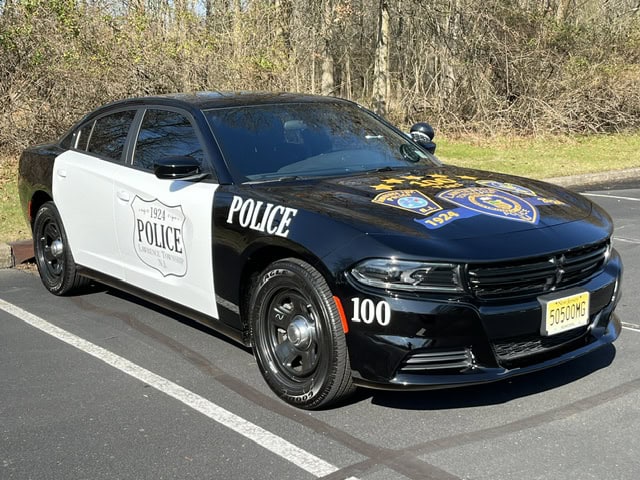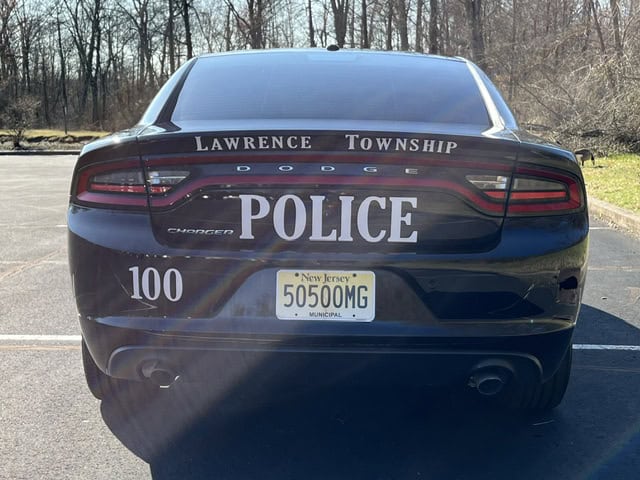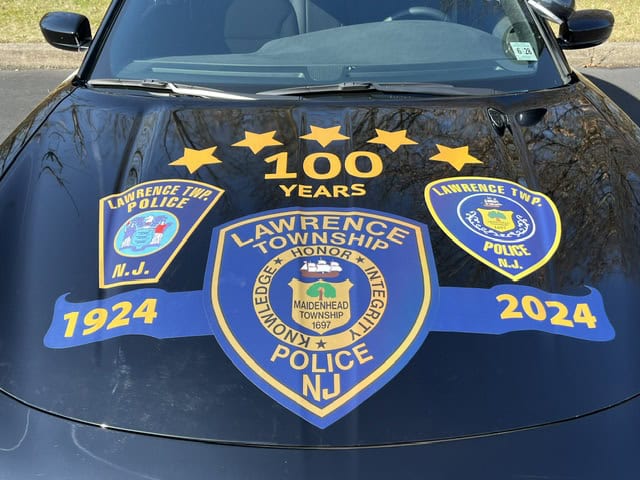The Lawrence Township Police Department marked its 100th anniversary last month, and now it is working on its second century.
While no one knows exactly when full-time police began in the township, the date, Feb. 23, 1924, is acknowledged as the Lawrence Township Police Department’s incorporation, according to Police Chief Christopher Longo.
“A lot has changed since 1924,” Longo said. “The size of our department has gone from a handful of police officers to well over 60 police officers. We are now in our fifth police department headquarters. We have had eight police chiefs. (Longo became the eighth police chief in 2022)
“There are several things that have remained constant throughout our history. Specifically, our mission, the quality and caliber of our officers and the partnerships that our agency has with the community. They will remain the core of our agency.”
To commemorate the 100th anniversary, Lawrence police officers have an opportunity to buy a special badge to be worn on their dress uniforms, Longo said.
A commemorative “challenge” coin will be available to the officers, he said. A challenge coin has the organization’s insignia or emblem, and is carried by its members. It is “a sign of pride.”
The Lawrence Township Police Department received a new Dodge Charger “retro” police car with “100” on the front fenders and a graphic on the door that says “Police” and “1924” to pay tribute to the centennial, Longo said. It is used as a patrol car and will be on display at special events.




History
Lawrence Township was settled in the late 1600s.
Law enforcement in the 1700s and 1800s was provided by constables – township residents who were elected to the position, according to an article written by the late Nicholas Loveless. It appeared in Lawrence Township’s tricentennial history book in 1997.
After the Civil War, the theft of horses became a problem. To combat horse thefts and other property crimes, the Lawrence Vigilante Society was organized in 1867, wrote Loveless, who was a former Lawrence police chief.
By the mid-1880s, state law allowed towns to appoint constables and members of a police force. Constables were nominated by political parties and elected to perform law enforcement duties, according to a history of policing written by Lawrence Historical Society member Laura Nawrocik.
James Appelget won election as constable in 1899. At some point, the job of elected constable became an appointed position. Special officers were appointed to fill out the ranks.
The lead constable was equivalent to the police chief. It was an on-call position and did not have regular hours. Appelget served until he died in 1920.
Joseph Leland Hopkins succeeded Appelget as the police chief – but in name only, Nawrocik wrote. The Lawrence Township Committee was in charge of the four constables and five special officers who were pressed into duty and paid by the hour, as needed.
The Lawrence Township Committee subsequently decided to elevate the chief of police to a full-time job and named Hopkins to the post. He had been serving in that capacity since Appelget’s death, Nawrocik wrote.
Hopkins, who was provided with a motorcycle for transportation and patrol duties, served as police chief until his death in 1935. Joseph Stonicker, who had been hired as a full-time police officer to assist Hopkins, became the police chief and served for 31 years.
Since Stonicker retired in 1966, there have been eight police chiefs. Stonicker was succeeded by William Seabridge, who was the police chief from 1966 to 1987.
Nicholas Loveless followed Seabridge as police chief, serving from 1987 to 1990. John Prettyman was the police chief from 1990 to 2002. Daniel Posluszny served as police chief from 2002 to 2014.
Mark Ubry followed Posluszny, and serve as police chief from 2014 to 2018. Brian Caloiaro served as the police chief for four years – from 2018 to 2022. He was succeeded by Longo.
The number of police officers has grown from six police officers in 1940 to 60 police officers in 2024 – including the police chief, Longo said.
There have been other changes along the way, Longo said. During Chief Hopkins’ tenure, the Lawrence Township Police Department had one motorcycle. Now, there are more than 20 patrol cars and motorcycles.
Police reports, which were filled out by hand and then typed, are now entered into computers in the patrol cars. In fact, one of the early police reports was typed by Stonicker while he was a patrol officer.
In that report, which was filed July 18, 1930, Stonicker wrote that he was dispatched to investigate a complaint about “something going on” at a house on Lawrence Road.
Stonicker discovered a still in the house that was used to make whiskey. Prohibition was in effect, and liquor was illegal to make, possess or consume. A still was used to distill ingredients to make liquor.
Police figured out who owned the still and made an arrest. The still was dismantled – three vats full of mash with a capacity of about 1,500 gallons, an electric pump and motor, a steam boiler and 70 barrels of corn sugar mash.
It was another case solved.


